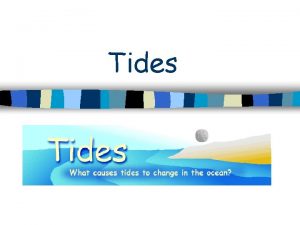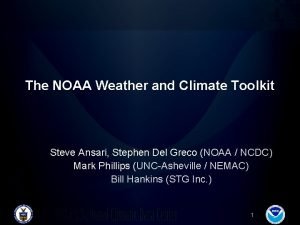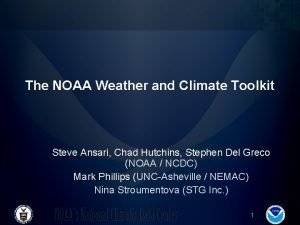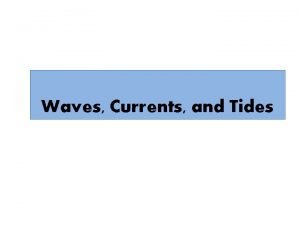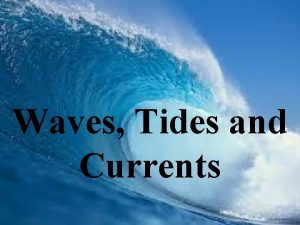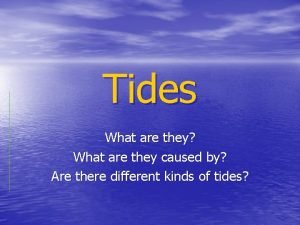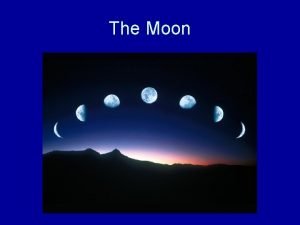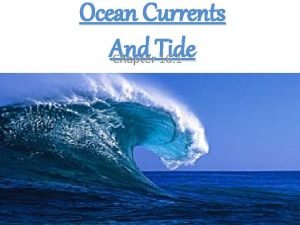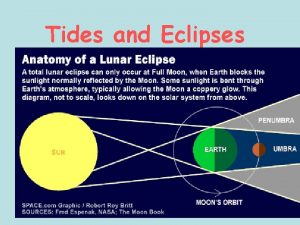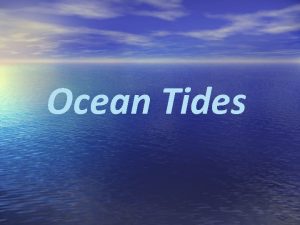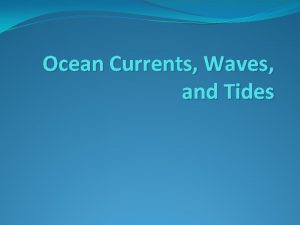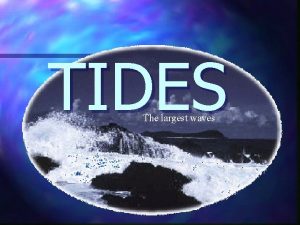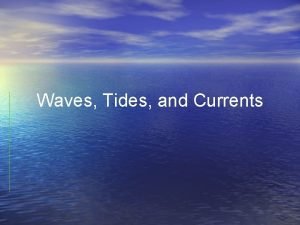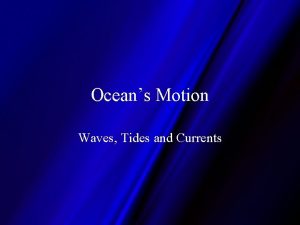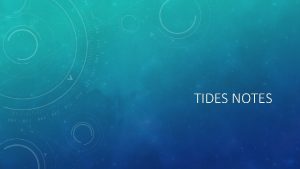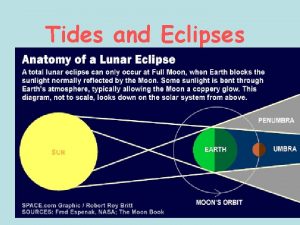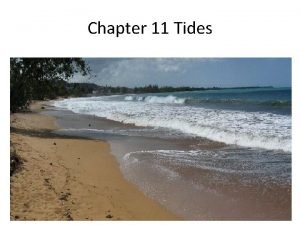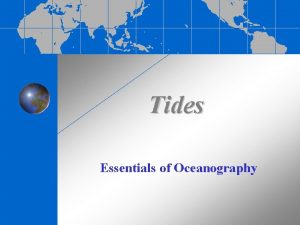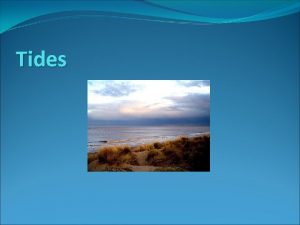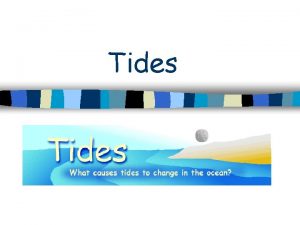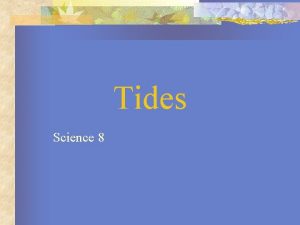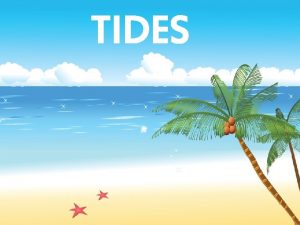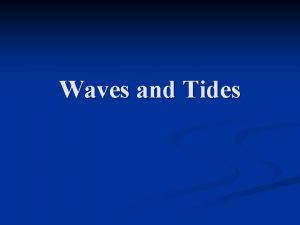Waves Currents and Tides Waves Currents Tides WCT
































- Slides: 32

Waves, Currents, and Tides

Waves, Currents, Tides (WCT) Cornell Notes Key Terms Summary: Notes

Engage • Study Jams: Waves and Currents • The class “WAVE” – How did we move? – Did we actually move around the classroom with the wave?

Introduction to Waves

Waves • A disturbance which moves through or over the surface of a fluid • Mostly caused by winds Caused by: • Wind • Earthquakes • Gravitational force of the Moon and Sun. • Form of great energy

Wave Characteristics • Parts of a Wave – Crest = high point – Trough = low point – Height = vertical distance from crest to trough – Wavelength = Horizontal distance between crest to crest or trough to trough

OCEAN WAVES • A wave is the movement of energy through water.

What causes waves? • Waves form from wind • Waves form out in the open ocean, and travel inwards to the shore.

What are the effects of waves? • Waves can erode and deposit sediment, changing the shape of the beach

BIGGER winds create BIGGER waves

Tsunamis • Tsunamis (underwater waves) are giant ocean wave caused by earthquakes, landslides, and volcanic eruptions beneath the ocean floor – As tsunamis approach the shore, the waves come closer together and grow into a mountain of water

Tsunami Waves

• The energy from waves can carry materials to the seashore. Beatenup pieces of shells and rocks can be carried to a beach by pounding waves. In Australia, a huge amount of sea foam was once carried in!


Wave Movement • When a wave passes through the ocean, individual water molecules move up and down but they do not move forward or backward.



Tides • Tides are the movement of ocean water at the shore when it rises and falls during the day • High and Low tides occur 2 times per day

Types of Tides • Spring Tide - Moon and sun are in direct line with one another - Results in unusually high tidal range -Tidal Range = vertical distance between high & low tides – 2 x’s/month

• Neap Tide – sun and moon are at right angles – Pulls cancel each other out – causes a weak pull – unusually low tidal range – 2 x’s / month

What causes tides? • The gravitational pull of the moon and sun on Earth’s water • High tides occur when the moon and sun are lined up on the same side of the Earth

What are the effects of Tides? • High tides: Water level is high on shore • Low tides: Water level is low on shore

Currents

What are ocean currents? http: //www. brainpop. com/science/earthsystem/oceancurrents/ • Ocean Current: mass of ocean water moving from one place to another. • 2 types of currents: – Surface current – Thermohaline (Deep water) current

What causes Surface Currents? • Surface currents: horizontally flowing currents caused by global and seasonal winds • Usually warmer-water • Direction of currents is caused by Coriolis Effect

Coriolis Effect • Coriolis Effect: Earth’s rotation causes objects in the N. hemisphere move clockwise, objects in S. hemisphere to move counterclockwise

Demo: Deep Ocean Currents • http: //www. youtube. co m/watch? v=I 8 k. To. TROC HA

What causes deep ocean currents? Temperature = least dense = floating water Temperature = more dense = water sinks • Thermo = heat, haline = salt Deep ocean currents are vertical currents caused by differences in density and temperature ( water masses rise and fall) • Usually colder water

This diagram is a view of the deep ocean currents of the world.

What are the effects of currents? • Currents affect the climate of a location – Warm-water currents warm up climate, cold water currents cool down climate • Surface currents form large circular patterns called gyre.

“Global Conveyor Belt” • When combined with surface currents it results in a conveyor-belt movement of water around the globe!

Check for Understanding • When the temperature of these currents decrease, what will happen to the density? The density will increase • Will cold ocean water sink toward the bottom or rise to the surface? Cold water will sink the bottom because it is more dense (Convection!!!!)
 Ocean currents waves and tides
Ocean currents waves and tides Spring tide position
Spring tide position Periodic rise and fall of sea level
Periodic rise and fall of sea level Wct+
Wct+ Types of frequency modulation
Types of frequency modulation Noaa wct
Noaa wct Noaa wct
Noaa wct What is deep current
What is deep current Diurnal tides
Diurnal tides Study jams waves and currents
Study jams waves and currents West australian current
West australian current Compare and contrast p waves and s waves using venn diagram
Compare and contrast p waves and s waves using venn diagram Mechanical waves examples
Mechanical waves examples Mechanical wave and electromagnetic wave
Mechanical wave and electromagnetic wave Difference between electromagnetic and mechanical waves
Difference between electromagnetic and mechanical waves Carbon dioxide temperature
Carbon dioxide temperature Mechanical waves and electromagnetic waves similarities
Mechanical waves and electromagnetic waves similarities Similarities of mechanical and electromagnetic waves
Similarities of mechanical and electromagnetic waves Seismic waves
Seismic waves Mechanical and electromagnetic waves
Mechanical and electromagnetic waves What are constructive waves
What are constructive waves Transverse wave vs longitudinal wave
Transverse wave vs longitudinal wave What type of waves are sound waves? *
What type of waves are sound waves? * Sound waves longitudinal waves
Sound waves longitudinal waves Mechanical waves vs electromagnetic waves
Mechanical waves vs electromagnetic waves Seismic waves are mechanical waves
Seismic waves are mechanical waves What are tides and how are they caused
What are tides and how are they caused During which phase of the moon do neap tides occur?
During which phase of the moon do neap tides occur? Neap and spring tides
Neap and spring tides Shifting tides timeline and map
Shifting tides timeline and map Shifting tides timeline and map
Shifting tides timeline and map Shifting tides timeline and map
Shifting tides timeline and map Tides and eclipses
Tides and eclipses


